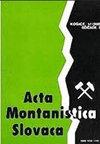可持续性背景下的废物管理系统
IF 2.2
4区 地球科学
Q2 GEOSCIENCES, MULTIDISCIPLINARY
引用次数: 0
摘要
本文从可持续发展的角度论述了部分城市的废物管理系统。作者团队的目标是根据对废物量和系统成本有重大影响的分类组别,找到关键的废物组别,从而为管理决策提供便利。为了从法定市政当局的角度优化整个废物管理系统的管理,首先必须将原有的 53 个废物项目清单大幅缩减。在废物管理专家的帮助下,确定了减少废物输入项目数量的标准,最终将统计样本减少到 27 个项目。每个项目都以每年的废物量和每年的系统成本进行量化。数学装置主要包括计算平均值以及废物数量和成本的边际斜率。各组废物之间的相互关系用图形记录在感知图中。个别分析主要是针对一个法定城市进行的,其次将结果与较小的城镇和小村庄进行比较。分析程序证实,混合城市垃圾的基本成分目录可以大大减少二次资源管理的决策。每组垃圾的数量会对整个垃圾管理系统的成本产生重大影响。在最初的 15 组废物中,只有三组似乎是主要的。城市垃圾组甚至对垃圾数量和整个系统的成本都有决定性的影响。有了这些发现,无论是从管理者还是从法定城市管理的角度来看,都可以把重点放在这个包含 13 个原始目录项目的核心组上。本文章由计算机程序翻译,如有差异,请以英文原文为准。
Waste management systems in the context of sustainability
The present paper deals with waste management systems in the context of sustainability in selected municipalities. The author's team aimed to find the key waste groups according to the classification groups that have a major impact on the volume of waste and the cost of the system, thus facilitating management decision-making. In order to optimise the management of the entire waste management system from the perspective of the statutory municipality, it was first necessary to reduce the original list of 53 waste items to a significantly smaller number. With the help of waste management experts, criteria for reducing the number of waste input items were defined, resulting in a reduced statistical sample of 27 items. Each item is quantified by the amount of waste per year and the cost of the system per year. The mathematical apparatus consisted primarily of calculating average values as well as marginal slopes of waste quantity and cost. The interrelationships between waste groups were graphically recorded in perceptual maps. The individual analyses were carried out primarily for a statutory city, with secondary comparisons of the results with smaller towns and small villages. The analytical procedures verified that the catalogue of basic components of mixed municipal waste can be significantly reduced for decision-making in secondary resource management. The amount of waste selected in each group significantly impacts the cost of the whole waste management system. Of the original 15 waste groups, only three groups appear to be the main ones. The municipal waste group even has a decisive influence on both the quantity of waste and the cost of the whole system. Thanks to these findings, from the point of view of both the manager and the management of the statutory city, it is possible to focus on this core group, which contains the 13 original catalogue items.
求助全文
通过发布文献求助,成功后即可免费获取论文全文。
去求助
来源期刊

Acta Montanistica Slovaca
地学-地球科学综合
CiteScore
3.60
自引率
12.50%
发文量
60
审稿时长
30 weeks
期刊介绍:
Acta Montanistica Slovaca publishes high quality articles on basic and applied research in the following fields:
geology and geological survey;
mining;
Earth resources;
underground engineering and geotechnics;
mining mechanization, mining transport, deep hole drilling;
ecotechnology and mineralurgy;
process control, automation and applied informatics in raw materials extraction, utilization and processing;
other similar fields.
Acta Montanistica Slovaca is the only scientific journal of this kind in Central, Eastern and South Eastern Europe.
The submitted manuscripts should contribute significantly to the international literature, even if the focus can be regional. Manuscripts should cite the extant and relevant international literature, should clearly state what the wider contribution is (e.g. a novel discovery, application of a new technique or methodology, application of an existing methodology to a new problem), and should discuss the importance of the work in the international context.
 求助内容:
求助内容: 应助结果提醒方式:
应助结果提醒方式:


